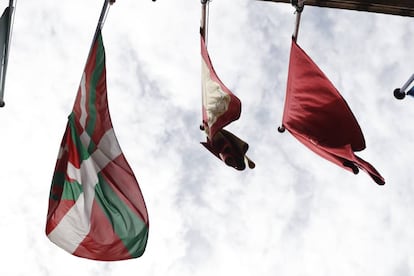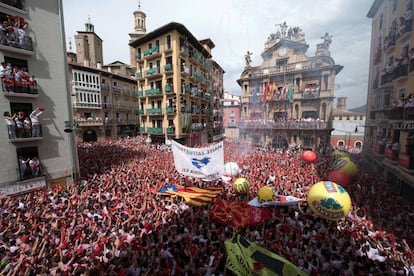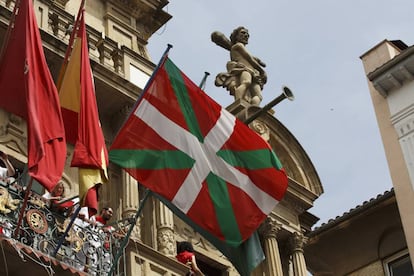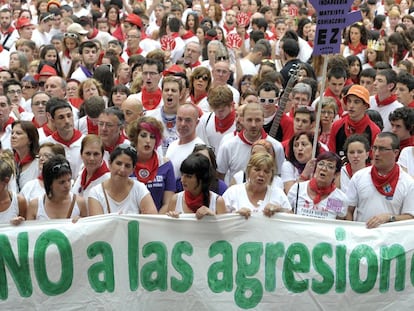Partying and politics mix at launch of Pamplona’s Sanfermines 2017
As thousands of revelers look on, local officials unfurl the Basque flag and hang it outside City Hall

Against a backdrop of hot weather, cloudy skies and political controversy, Pamplona inaugurated its world-famous Sanfermines on Thursday at noon.
Following tradition, a rocket was launched from a balcony at the seat of local government – an event known as the Chupinazo – setting off nine days of uninterrupted partying that will set the city back €1.3 million, a 3% increase from last year’s budget.
The official San Fermín 2017 program lists around 425 events between now and July 14, ranging from concerts to puppet theater, sports activities, dance shows, parades, fireworks displays, bullfights and religious events.

But the street celebrations – of which the morning bull runs are the best-known event – are just one part of the story. Underlying the Navarrese capital’s famous festival is a recurring political issue that becomes particularly visible at this time of the year.
Will it be there?
On Thursday morning, as the square in front of City Hall filled up with thousands of people, all eyes were trained on the main balcony to see whether the ikurriña – the official flag of the neighboring Basque Country – would fly among the other ensigns.
Although Navarre is not formally part of the Basque Country – it is a separate region in its own right – there are shared historical ties that pro-independence groups like to underscore.
Locals knew that in March of this year, the regional parliament had struck down a law forbidding the ikurriña from being hung alongside the official flag of Navarre. The Spanish government, in turn, had warned that the Basque flag would be illegal.
And the local government, whose mayor belongs to the nationalist group EH Bildu, had issued a report stating that existing regulations neither oblige nor forbid the city from flying the Basque flag. EH Bildu, like other leftist, pro-independence groups in the region, supports the idea of a wider Basque nation that goes beyond the official Basque provinces of Guipúzcoa, Vizcaya and Álava, and which encompasses Navarre as well as parts of southern France.

As revelers watched, city employees unfurled an ikurriña from the balcony just minutes before the rocket launch. Flying next to it were the flags of Pamplona, Navarre, Spain and the European Union.
Spanish government authorities immediately filed an official administrative complaint against the move. This is not the first time that the Basque flag has sneaked in among the others – it happened in 2015 as well. Local authorities claimed at the time that it was done as a courtesy to three Basque parliament members from EH Bildu who had been asked to attend the Chupinazo as official guests.
Non-stop action
The partying and the politics also leaves some room for religion. The main event on Thursday, outside the Chupinazo itself, is the Marcha a Vísperas, a concert scheduled for 8pm inside the Church of San Lorenzo, where the choir of the Cathedral Music Chapel and the Navarre Symphony Orchestra will perform a religious piece by Mariano García and Fernando Remach.
Around 3,500 police officers will be patrolling the streets to keep the crowds under control. The population of Pamplona is expected to swell from 200,000 to around one million during the nine-day festival.
The morning bull runs, or encierros, are a major element of the Sanfermines, and as such, there will be 10 medical stands manned by 70 health professionals along the 850-meter route that the bulls will take each morning. A fleet of 16 ambulances will be dispatched to the area.
Figures released by local authorities show that there were 16,448 runners last year, or 181 fewer than in 2015.
English version by Susana Urra.
Tu suscripción se está usando en otro dispositivo
¿Quieres añadir otro usuario a tu suscripción?
Si continúas leyendo en este dispositivo, no se podrá leer en el otro.
FlechaTu suscripción se está usando en otro dispositivo y solo puedes acceder a EL PAÍS desde un dispositivo a la vez.
Si quieres compartir tu cuenta, cambia tu suscripción a la modalidad Premium, así podrás añadir otro usuario. Cada uno accederá con su propia cuenta de email, lo que os permitirá personalizar vuestra experiencia en EL PAÍS.
¿Tienes una suscripción de empresa? Accede aquí para contratar más cuentas.
En el caso de no saber quién está usando tu cuenta, te recomendamos cambiar tu contraseña aquí.
Si decides continuar compartiendo tu cuenta, este mensaje se mostrará en tu dispositivo y en el de la otra persona que está usando tu cuenta de forma indefinida, afectando a tu experiencia de lectura. Puedes consultar aquí los términos y condiciones de la suscripción digital.
More information
Archived In
Últimas noticias
Rowan Atkinson tops Netflix at 70: ‘He’s as funny as ever’
Israeli recognition of Somaliland stirs up the Gulf
Tiger Woods turns 50: Will he continue playing on the PGA Tour or take a back seat?
The surreal journey of James Nnaji, the Barcelona youth player selected in the NBA Draft who ended up in the NCAA
Most viewed
- Oona Chaplin: ‘I told James Cameron that I was living in a treehouse and starting a permaculture project with a friend’
- Reinhard Genzel, Nobel laureate in physics: ‘One-minute videos will never give you the truth’
- Sinaloa Cartel war is taking its toll on Los Chapitos
- Why the price of coffee has skyrocketed: from Brazilian plantations to specialty coffee houses
- Chevy Chase, the beloved comedian who was a monster off camera: ‘Not everyone hated him, just the people who’ve worked with him’










































